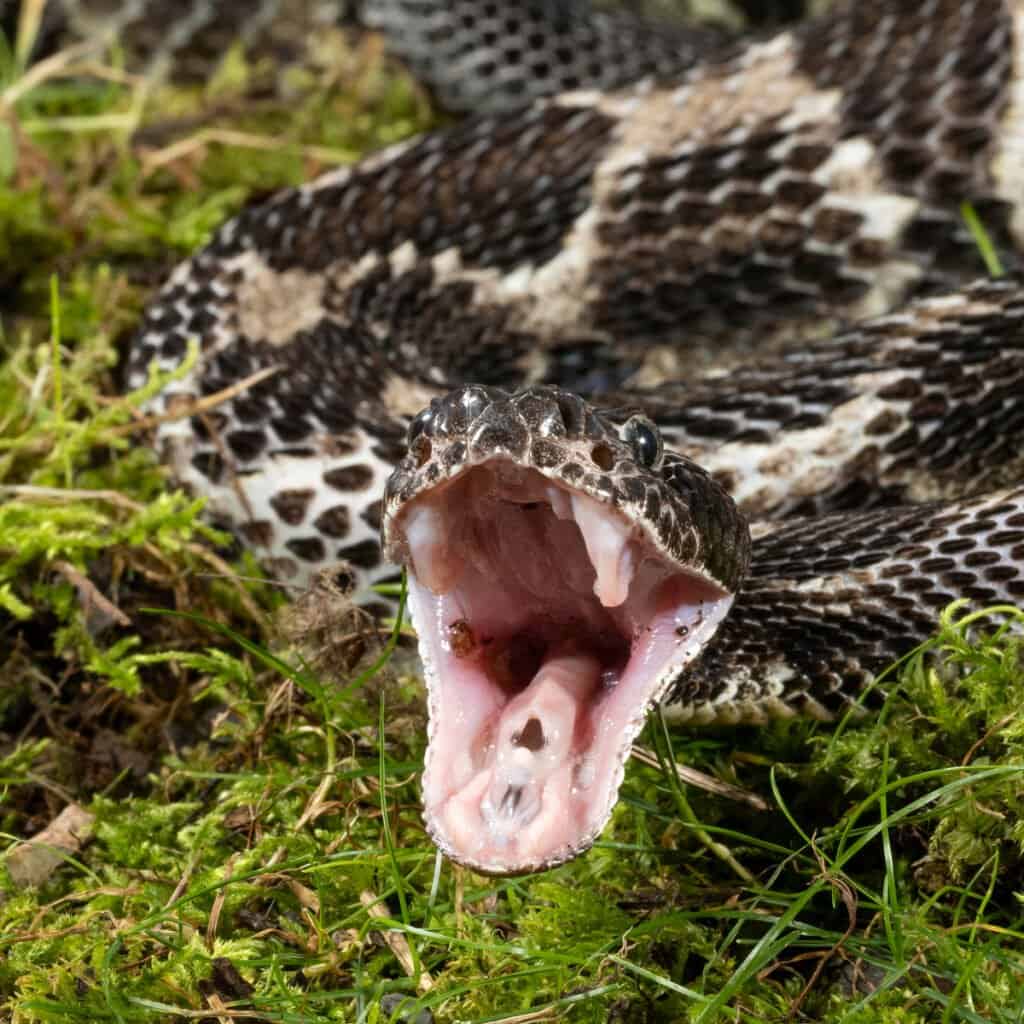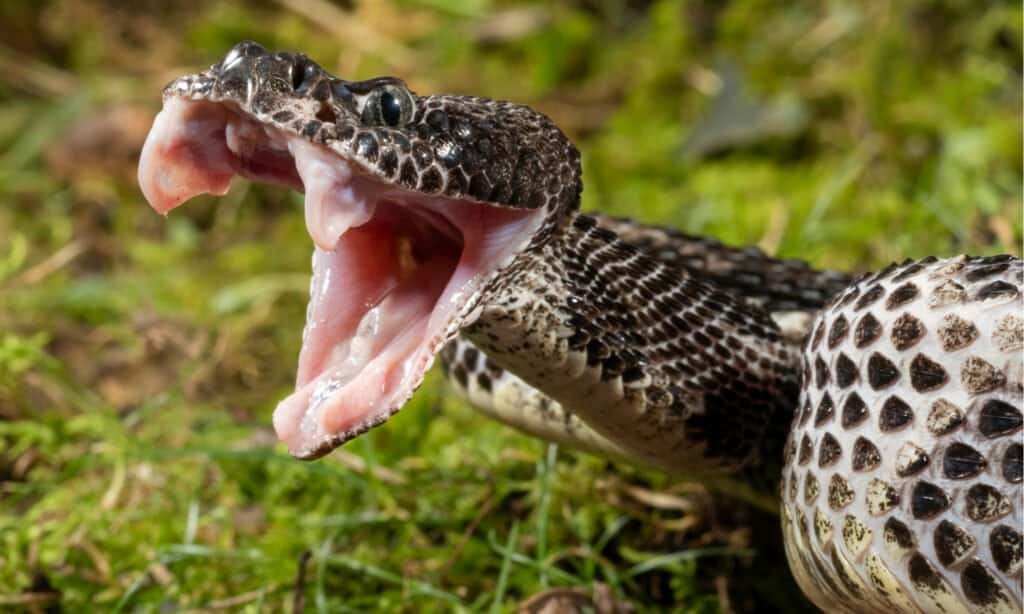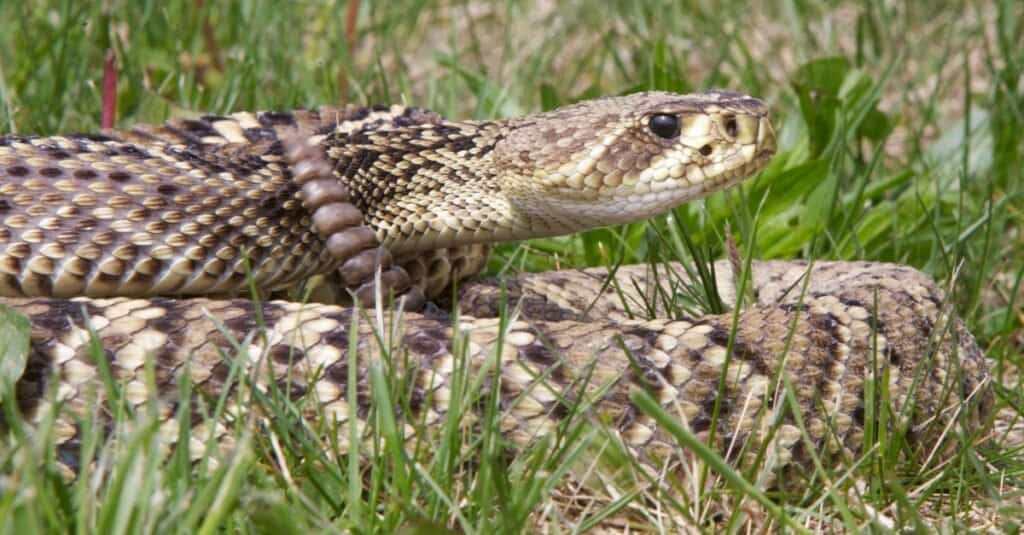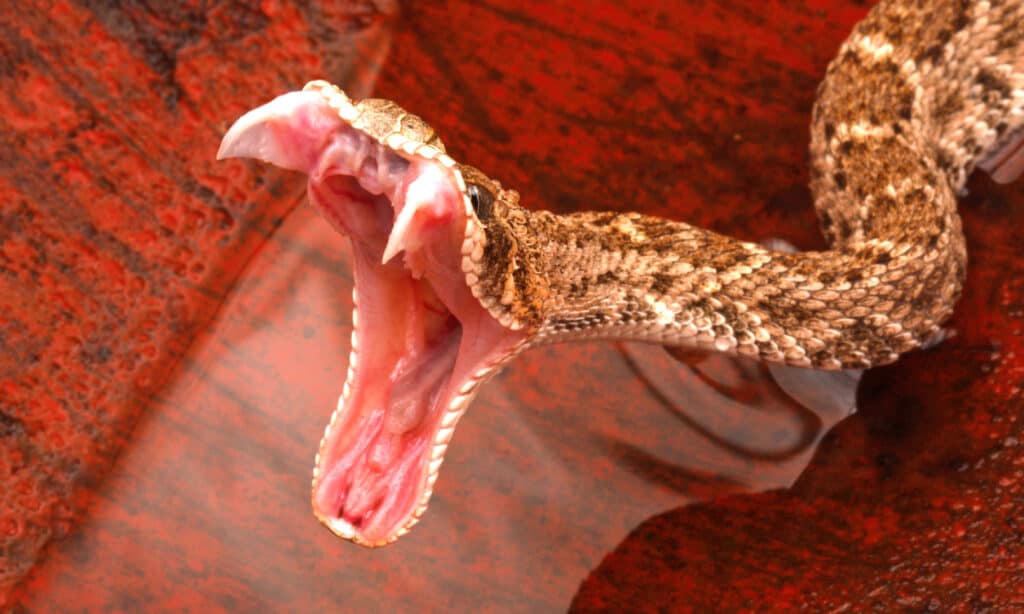Key Points:
- Timber rattlesnakes, while generally found on the ground, have also been known to climb trees up to 80 feet tall. They are also good swimmers, able to swim on the water’s surface and below it. Eastern diamondbacks can also swim well but don’t prefer the water, and they are not good climbers.
- The venom of an eastern diamondback snake, which it can inject in large quantities at once with its sharp, hinged fangs, contains hemotoxin, which can cause tissue damage and paralysis. A timber rattlesnake’s venom contains crotoxin, which causes pain, swelling, bleeding, and neurological symptoms in victims, and can kill humans.
- While the timber rattlesnake has a chevron pattern and a stripe running down its body, the eastern diamondback sports a diamond pattern along its body and has dark banded eyes.
Vipers like the timber rattlesnakes and the eastern diamondbacks are venomous snakes with long formidable fangs. They derive their family name Viperidae from the Latin vivus, “alive” and parere, “to bear.” This refers to their method of bearing young alive. The mother snakes of these species incubate fertilized eggs in their bodies before giving birth.
As pit vipers, they have specialized pit organs that act like infrared cameras to detect the heat shape of predators even in the deep dark of night. These serpentine rattlers share some intriguing features, but what makes them different?
Let’s snake through the diverse nature of the timber rattlesnake and eastern diamondback and see what sets these serpents apart.
Timber Rattlesnake vs. Eastern Diamondback: Comparison

| Timber Rattlesnake | Eastern Diamondback | |
|---|---|---|
| Scientific Name | Crotalus horridus | Crotalus adamanteus |
| Habitat & Range | The southeastern United States; mountainous & hilly forests, swamps, river floodplains, lowland cane thickets & fields | In the eastern United States; scrublands, coastal plains, pine forests, barrier islands, wet prairies, savannas, wetlands, abandoned farms & overgrown fields |
| Appearance | Chevron pattern and a stripe running down the body | Diamond pattern along body & dark banded eyes |
| Size | 2.5-5 feet long average, up to 7 feet; 1-3 pounds | 3-6 feet long average, up to 8 feet; 5-10 pounds |
| Behavior | More docile and prefers to retreat when threatened | More likely to stand their ground in the face of threat |
| Lifespan | 30+ years | 15-20 years |
Key Differences Between Timber Rattlesnakes and Eastern Diamondbacks
The key differences between timber rattlesnakes and eastern diamondbacks are their habitat and range, physical markings, size, and behavior.
Both of these snakes have long, hollow fangs to deliver powerful venom; they sense their prey with pit organs and warn of their strike with the shaking of rattles at the tip of their tails. Let’s find out where each lives, who grows to a larger size, and what other features make these rattling reptiles unique.
Scientific Classification
The timber rattlesnake and the eastern diamondback are both vipers of the family Viperidae. From there, they diverge. The timber rattlesnake also goes by the names American viper, black rattlesnake, eastern rattlesnake, timber rattler, and canebrake. Its scientific name is Crotalus horridus. Crotalus is derived from krotalon, Greek for the rattle. Most of the world’s rattlesnakes are part of this genus, including the eastern diamondback, western diamondback, and the sidewinder. The species name horridus comes from the Latin horreō, meaning “to stand on end or shiver.”
The eastern diamondback is sometimes called the Florida rattler or the common rattlesnake. Its scientific name is Crotalus adamanteus. The species name adamanteus roughly translates to “hard as unbreakable steel.” So, the entire species’ name refers to this snake having a rattle as hard as steel.
Habitat and Range

Timber rattlesnakes inhabit the eastern United States.
©Scott Delony/Shutterstock.com
You can find timber rattlesnakes spread widely across the eastern United States. They are regionally extinct in Canada and threatened in several parts of their range. They live in mountainous or hilly forests, swamps, wetlands, river floodplains, lowland cane thickets, and fields.
Although primarily terrestrial snakes, timber rattlers are excellent climbers and have been found in trees at points higher than 80 feet. They are also good swimmers, able to swim on the water’s surface and below it. In the winter, they hibernate in crevices and burrows.
Eastern diamondbacks live in the southeastern United States. They inhabit scrublands, coastal plains, pine forests, and barrier islands. They also live in wet prairies and savannas and around wetlands as well as abandoned farms and overgrown fields.
Diamondbacks tend not to prefer wet areas, but they are adept swimmers and can swim in saltwater between reefs and along swamp edges when necessary. Although they can sometimes be found in bushes and trees in search of prey, they aren’t adept climbers.
In cold weather, they’ll also hibernate, finding similar abandoned burrows, nooks, and tree stumps.
Appearance

The eastern diamondback has a chevron and diamond-shaped body pattern.
©Chase D’animulls/Shutterstock.com
As pit vipers, both of these snakes have vertical, cat-like pupils and a large sensory pit between their nostrils and eye on each side of their face. These pit organs contain a membrane that can detect infrared radiation from warm bodies up to about 3 feet away. This provides them with the unique capacity to detect prey.
The timber rattlesnake is generally gray, sometimes with a pinkish hue to its body. It has a stripe running down its back that’s darker brown or black in some. In others, it’s orange, yellow, or pinkish. All have darker coloration at their tail tips and dark stripes that form a chevron pattern along their back and sides.
This body coloration acts as camouflage as they slide along the vegetation on the ground. The timber rattlesnake has keeled scales, which feature a ridge down the center instead of being smooth.
The eastern diamondback varies in color from blackish-gray or muddy gray to olive green. Light reflected off its keeled scales gives its skin a dull rather than shiny appearance.
Its tail is generally a different shade than its body, somewhere between brown and gray with banded rings. The distinguishing feature of this species is the diamond-shaped pattern along its back and the black band that covers its eyes, outlined by two pale lines.
Size
The timber rattlesnake has a large and heavy body. Adults of this species typically grow to be 2.5 to 5 feet in length, but there are reports of 7-foot-long snakes. They weigh 1 to 3 pounds, on average. As North America’s longest and heaviest venomous snake, the eastern diamondback tends to be larger than the timber.
On average, they reach 3 to 6 feet long, but some can grow to be 8 feet. These snakes average about 5 to 10 pounds.
Behavior

The timber rattlesnake’s long fangs can deliver a potent venom.
©Joe McDonald/Shutterstock.com
As one of the most dangerous animals in the eastern U.S., timber rattlesnakes are to be respected. When threatened, they prop themselves up and shake their rattles, producing a crisp warning sound before a potential strike. Long fangs deliver powerful venom that’s potent enough to kill a human.
When a bite does occur, the venom will start to produce pain, swelling, bleeding, and neurological symptoms. A defining characteristic of the timber rattlesnake is crotoxin or the “canebrake toxin.” This is a potent neurotoxin that can lead to paralysis.
Although bites are rare, immediate medical attention is necessary. However, the timber rattlesnake is more docile than other vipers and would prefer to stay coiled or stretched out and motionless when encountered. Unless threatened or provoked, this snake will only strike humans after performing a long series of rattling and defensive maneuvers.
Eastern diamondbacks are notorious for their powerful rattle and painful, potentially-fatal bite. They are more likely to stand their ground in the face of a threat than to retreat. The hemotoxin in their venom kills red blood cells and causes tissue damage.
Their venom-delivery system is highly effective. They have two hinged fangs attached to venom glands and can inject a large quantity of venom into their victims. Bites need immediate medical treatment, but human deaths are rare since antivenom is widely available.
As far as diet goes, the timber rattlesnake eats birds, lizards, amphibians, chipmunks, squirrels, and other rodents. Eastern diamondback rattlesnakes prefer to feast on rats and mice, rabbits, squirrels, and birds.
Is it Normal for a Timber Rattlesnake to Attack an Eastern Diamondback?

Despite potentially aggressive behavior towards each other, it’s uncommon for a timber rattlesnake to attack an eastern diamondback.
©Joe McDonald/Shutterstock.com
The timber rattlesnake and the eastern diamondback are both venomous snakes that are found in the southeastern United States. While they are known to be territorial and can be aggressive toward other snakes, it is not common for a timber rattlesnake to attack an eastern diamondback.
Both species are known for their venomous bites, and they will often compete for resources such as food and shelter. They may also encounter each other when they are basking in the sun or searching for a mate.
However, despite their potentially aggressive behavior towards each other, it is not common for a timber rattlesnake to attack an eastern diamondback. In fact, both species are more likely to avoid each other and retreat when they encounter one another.
If a timber rattlesnake and an eastern diamondback do engage in a fight, it is usually a display of dominance rather than an actual attempt to kill or injure the other snake. They will often engage in a ritualized combat that involves body posturing, head-butting, and coiling around each other.
Bonus: What U.S. Rattlesnake Species Are the Most Dangerous?
Rattlesnakes are among the most deadly venomous snakes in the U.S. But their bites vary in toxicity, so it’s a good idea to be educated on what rattlesnakes are the most dangerous.
Mojave Green Rattlesnake

Some experts classify the Mojave green rattlesnake as the deadliest rattlesnake species in the United States.
©iStock.com/Shoemcfly
Many experts classify the Mojave green rattlesnake, native to the Southwestern U.S. as well as Mexico, as the deadliest rattlesnake species on Earth. Its venom, which can be either hemotoxic or neurotoxic, can cause symptoms like vision impairment, difficulty swallowing and breathing, muscle weakness, severe body pain, convulsions, and death by cardiac arrest or respiratory failure if left untreated.
Eastern Diamondback Rattlesnake

The Eastern diamondback rattlesnake is responsible for the most deaths in the U.S. from snake bites.
©iStock.com/NajaShots
This rattler is another contender for the deadliest rattlesnake in the United States. It’s also one of the largest snakes in the U.S., growing to a max length of 8.5 feet and max weight of 34 pounds. Its bite contains hemotoxic venom, capable of killing red blood cells and causing tissue damage. Another problem lies in the fact it can deliver 400-700 mg of venom in its bite, compared to 200-300 mg in the western diamondback rattlesnake, so its venom can lead to death. The Eastern diamondback rattlesnake is recognized as being responsible for the most deaths by snakebite in the U.S.
Western Diamondback Rattlesnake

The venom from a Western diamondback rattlesnake is hemotoxic, attacking red blood cells and causing tissue damage to bite victims.
©iStock.com/johnaudrey
Close on the heels of the Eastern variety is the Western diamondback rattlesnake, native to the U.S. Southwest and northern Mexico. Its venom is hemotoxic, killing cells and tissue, causing blood clotting (or preventing clotting) that can result in massive internal bleeding, and causing possible cardiovascular failure. Some experts think this type of rattlesnake actually outranks the Eastern diamondback in terms of overall deaths to humans.
Other deadly U.S. rattlesnake species include:
- Timber Rattlesnake
- Massasauga Rattlesnake
- Southern Pacific Rattlesnake
- Banded Rock Rattlesnake
- Desert Massasauga Rattlesnake
The photo featured at the top of this post is © bradenjalexander/Shutterstock.com
Discover the "Monster" Snake 5X Bigger than an Anaconda
Every day A-Z Animals sends out some of the most incredible facts in the world from our free newsletter. Want to discover the 10 most beautiful snakes in the world, a "snake island" where you're never more than 3 feet from danger, or a "monster" snake 5X larger than an anaconda? Then sign up right now and you'll start receiving our daily newsletter absolutely free.
Thank you for reading! Have some feedback for us? Contact the AZ Animals editorial team.






